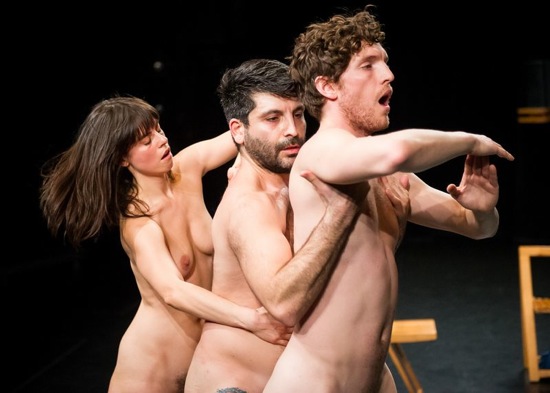
(L to R) Maggie Thom, Kayvon Pourazar, and Benjamin Asriel in Juliana F. May’s Commentary = not thing. Photo: Ian Douglas
Over the years, thoughtful choreographers have turned to nature as a way of thinking about choreography. Isadora Duncan was drawn to wind and wave motion, Martha Graham to the ways in which emotion structures the body, Merce Cunningham to ideas about chance and indeterminacy in nature’s processes.
It’s an interesting coincidence that, just recently, two groups—Jennifer Monson/iLAND at the Kitchen, February 14-23, and Juliana F. May/MAYDANCE at New York Live Arts, February 19-23) presented works that delved into the relationship among humans, creatures, and the terrain they share (Monson’s Live Dancing Archive) and primal stages of human development (May’s Commentary = not thing).
Live Dancing Archive is an evening-length solo for Monson (her first). It’s part of a triptych that includes a three-hour video loop showing documentation of her 2002 BIRD BRAIN Osprey Migration, and a web-based archive: www.livedancingarchive.org. Beginning with her 2000 The Pigeon Project, Monson set herself to explore migration patterns and the impact of environment on the behavior of birds and whales—traveling to different outdoor sites (some shown in the online archive) and feeling the influence of terrain on the human dancing body. “Furthermore,” says The Kitchen’s press release, “the piece looks at how Monson’s navigation of her own queer, feminist, and animal-like body has shaped relationships to cultural and social phenomena.”
I was, unfortunately, unable to make it to the installation (viewable at the Kitchen during the run, but not immediately before and after the evening performances). Monson’s immediate source for the choreography was the video documentation of four improvised solos danced on Okracoke Island, North Carolina, by Monson, Javier Cardona, Morgan Thorson, and Alejandra Martorell. There are, then, many layers of experience at work in the solo. I can sense their presence and their influence, but they remain mysterious, so deeply has Monson absorbed them into her dancing body.
Aided by lighting designer Joe Levasseur, she turns the Kitchen’s black-box theater into a shifting environment in very down-to-earth ways. Various lighting instruments can be moved around by Monson or by someone else (production manager Davison Scandrett perhaps). One of them may be aimed at a patch of floor for a while. At another point, a lamp held up to reveal a high far corner, is turned slightly to slant along the rear wall; suddenly the wall’s black-painted brick surface resembles wind-patterned sand. In order to reconfigure the space further, Monson and/or her assistant also move a narrow, horizontal, white panel that’s suspended between two poles on wheels. Jeff Kolar produces his score on two consoles—one on either side of the stage; the sounds hint at winds and distant upheavals and, once, the speakers emit a prolonged, apocalyptic crashing that makes the audience’s chairs and stomachs vibrate. For a while, we hear clicking, like that of a film projector.
In this place of shadows, darkness, and sudden glare, Monson—a strong, solidly built woman with a weather-beaten look—dances with fearless, fluid power. Most of the time she’s wearing tights and a chest-piece that suggests both feathers and a hairy pelt. Once, a dresser (Tatyana Tenenbaum) helps her into long, floating sleeves, tops her head with a blond wig, and applies red lipstick to her mouth; thus accoutered, Monson lip synchs a song. Sometimes she’s naked. Sometimes she hurtles around in a billowing cloud of a dress. Sometimes she lets down her hair and whips it around.
There is so much going on with her—in her. She may stand and make small deliberate gestures. She may seem to grow wings. She may suddenly reel and stagger and flap her arms, gallop crazily. She may collapse, lie down, roll, crouch, kneel, crawl, run, take wide, stiff-legged steps. She may organize her feet into ballet’s fifth position and then tip into a handstand. She can seem pensive, ill at ease, frisky. Yet somehow in this increasingly arduous solo, all these strands fuse—memories and experiences and visions of places and people close to her put through the transformer of her dancing self.
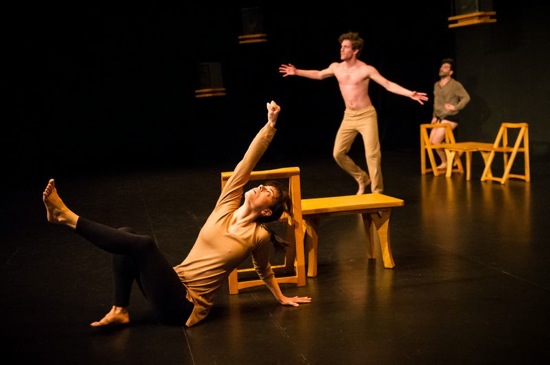
(L to R) Maggie Thom, Benjamin Asriel, and Kayvon Pourazar in Juliana F. May’s Commentary = not thing. Photo: Ian Douglas
The environment in Juliana May’s Commentary=not thing could be the inside of someone’s psyche or a surreal nursery or a very large psychiatrist’s couch. And she wants us, the spectators, very close to the performers and not looking down at them. New York Live Arts’ usual ramped seating is off limits. Instead, we sit in two or three rows on two sides of the performing area.
The three dancers—Benjamin Asriel, Kayvon Pourazar, and Maggie Thom—use their considerable physical skills and articulateness to access states that (at least in the first part) precede language and efficient motion. They hold up their arms and swat the air, or bounce it between their hands. As they lurch and spin around the space, their bodies are delivering messages to themselves—often as incoherent as their voices. For a long time, the only intelligible word is “party,” because they speak on an intake of breath, which garbles the words and makes language sound like something they’re trying to eat.
The point, I think, is not that these smart and very courageous performers are mimicking infants in some stylized way; instead, May is suggesting that primal, pre-cognitive states stay buried in our guts; even as we’re growing up civilized, they’re howling and shitting at some level we fear to access.
You can see that most of the wildness is choreographed, that themes vary and seemingly ungovernable actions repeat exactly. On the other hand, there are times when two of the performers watch the third so closely that he or she must be improvising the role of temporary leader. In the beginning, they’re barely aware of one another, but gradually begin to make contact verbally and physically. While Asriel sets up three chairs around a small table, then strips off his clothes and sits down, Thom and Pourazar keep dancing around, uttering parts of a sometimes unintelligible dialogue that begins “This was supposed to be fun” and progresses through “I don’t know why I came with you down here” to the response, “because you’re my wife.” Asriel looks from one to the other like a child watching quarreling parents. Before long, all three are sitting around the table naked. Their angry remarks don’t always relate in obvious ways. Pourazar’s “Get off the fucking chair!” is answered by Thom’s holding up a pretend camera and saying, “I see you.”
As they continue to move about, their words connect more to their own drives and how they want to be seen. Asriel and Thom chant phrases, while Pourazar, over and over, repeats a strenuous solo fragment that ends with his stepping up onto the table. In the most sustained and primal sequence, they begin marching around the space in a line, while the four handsome, suspended speakers (set design by Brad Kisicki) begin to emit Chris Seeds’ recorded music for drums (Otto Hauser) and viola (Luke Kissell). Gradually the three move closer together as they walk, their mouths open like those of baby birds perennially expecting a meal. Those not first in line massage the spine in front of them or mess the hair. Then, changing leaders frequently, each of the two in back sticks one arm between the legs of the person in in front and marches on with a handful of genitalia.
They exit and return clothed after the stage is cleared of furniture and debris (the chairs return later, plus two little tables, but hardly get used). The costumes, by the way, are credited to Reid Barthelme, but are likely the most workaday he’s ever designed. It’s difficult to tell what has changed. The three speak more clearly and dance strenuously, recycling many of their earlier gestures, picking up movements from one another, essaying big, space-grabbing solos. One fragmented, repeated and tossed-around dialogue seems to conflate a child’s memory of a museum trip with parents and a lovers’ quarrel. A reiterated, laughing tussle between the two men involves some garments being pulled off, and at some point various of the performers get slammed against the back wall and pressed up until their feet are off the ground.
It seems fitting that, as Chloe Z Brown’s lighting fades out, the three valiant dancers are spinning and spinning and spinning. I’m not sure however, if all that they’ve experienced is being broken down into something else by a virtual centrifuge. I think more of a clothes dryer going round and round with its load. At the end, you put all that stuff on again, the same but a bit cleaner.

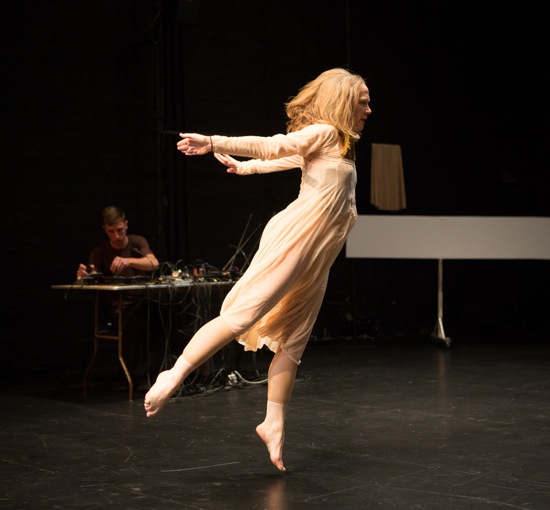
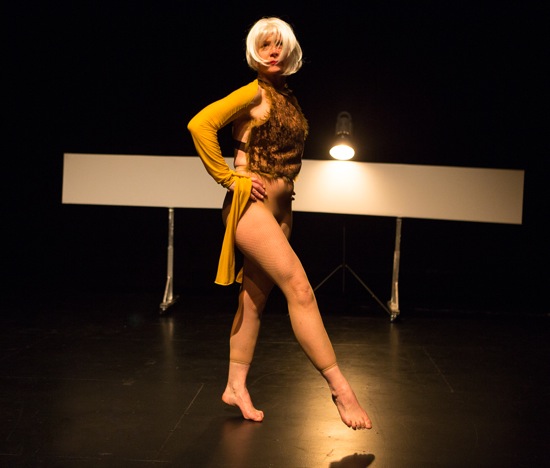
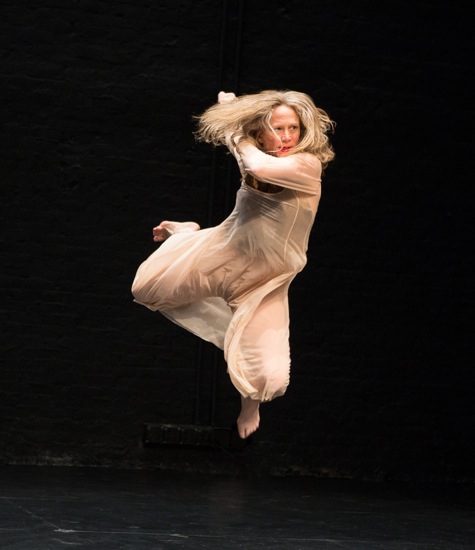
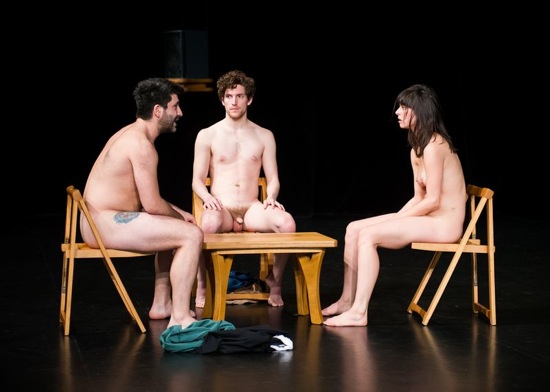
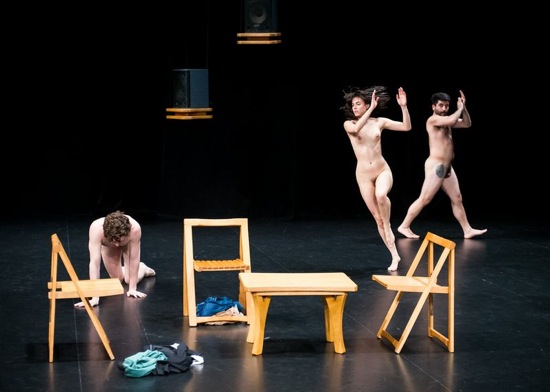
Thanks for one’s marvelous posting! I seriously enjoyed reading it, you will be a great author. I will be sure to bookmark your blog and definitely will come back at some point. I want to encourage continue your great work, have a nice holiday weekend!
A lot of thanks for all your valuable work on this blog. My mum really likes doing investigation and it’s easy to see why. All of us learn all of the powerful method you offer rewarding solutions by means of this web site and as well strongly encourage response from other people on this content and our own princess is without a doubt becoming educated a great deal. Enjoy the rest of the year. You are always carrying out a fabulous job.
Appreciation to my father who informed me regarding this website,
this website is truly awesome.